



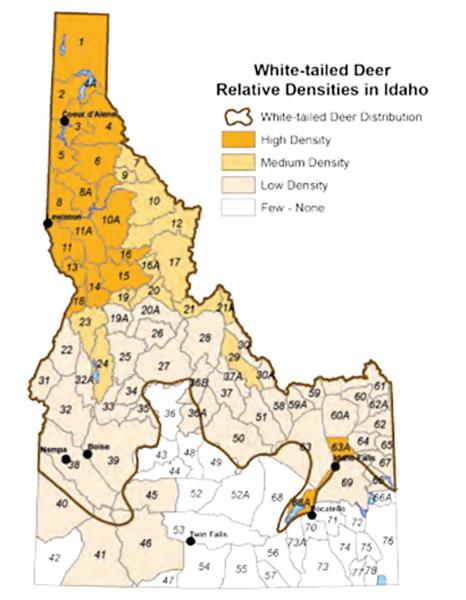

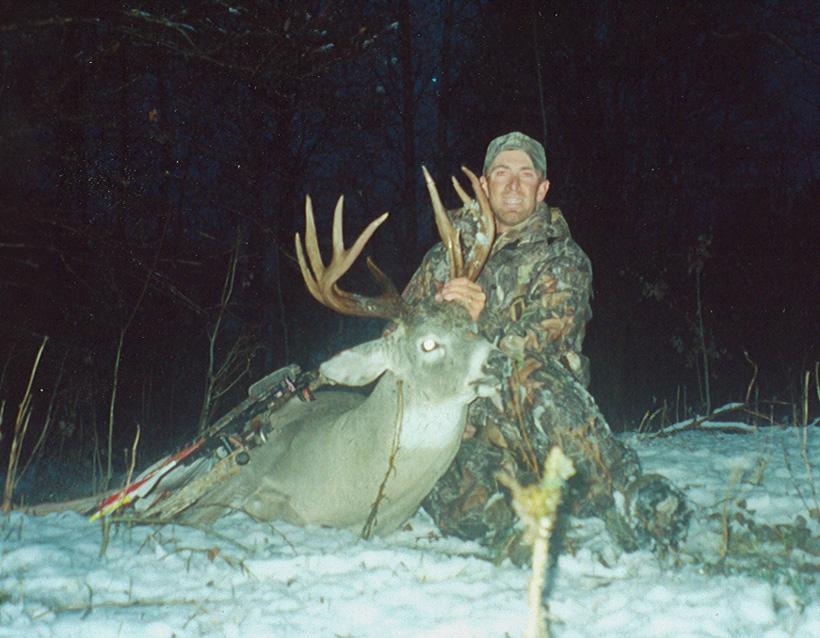
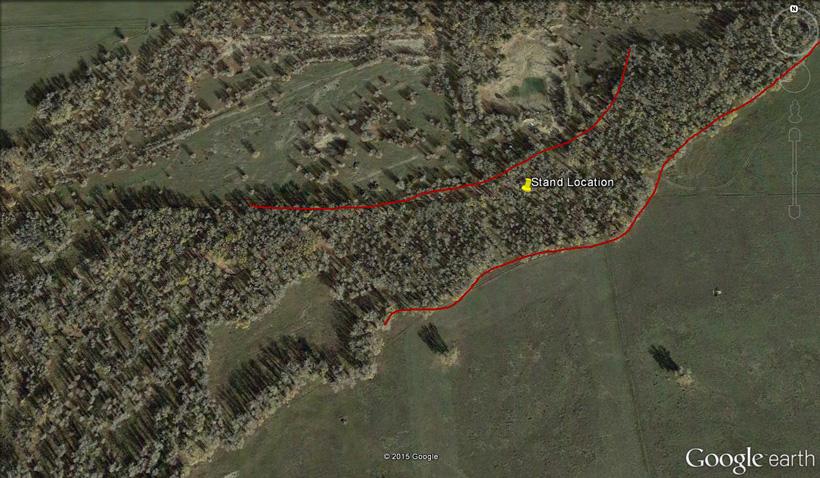
Timber funnel.
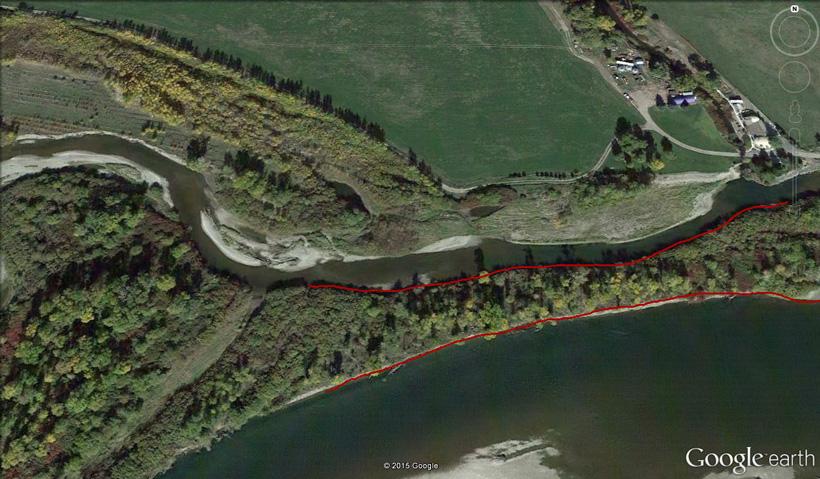
River funnel.
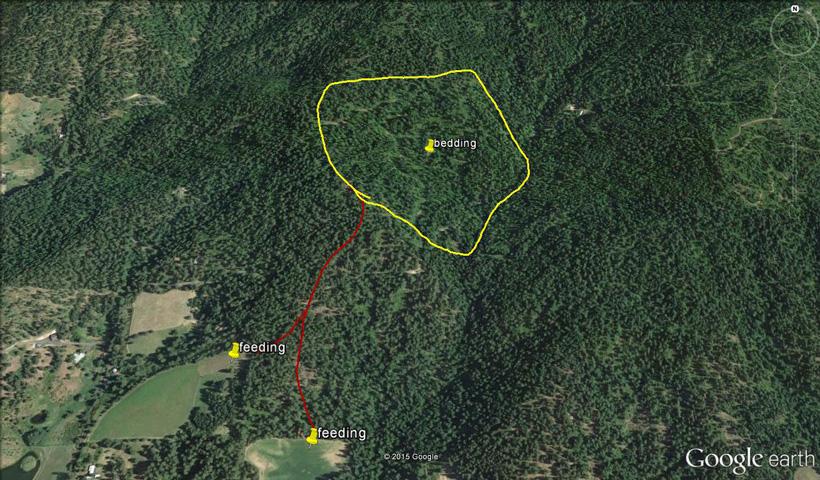
Ridgeline funnel.

Year after year Idaho has become increasingly well known for its whitetail hunting opportunities. Although it has been home to a healthy population of whitetails for many years, it has only recently begun to find its spot on the map as a premier whitetail hunting destination. Whitetails are survivors and, despite very liberal hunting seasons throughout the state, their populations are thriving and continue to grow in most areas.
Hunting whitetails in Idaho is not an especially cheap endeavor but it is something that can be done year after year without having to draw a tag. Nonresidents will have to purchase a hunting license for $154.75 (or hunting/fishing combo for $240) and a deer tag for $301.75. If you decide to pursue them with a stick and string you will also be required to buy an archery permit for $20. Likewise, if hunting with a muzzleloader is more your style, that will cost you an extra $20 for a muzzleloader permit. Camping, lodging, meals and travel will also need to be figured into your budget. For more detailed information you can check out our Idaho State Profile.
Idaho offers two types of deer tags: the regular deer tag is good for either whitetail or mule deer, depending on the unit and season that is open at the time; the whitetail tag is only good for whitetail deer and is the required tag for many of the best whitetail hunting areas and seasons. The tag you need depends on which area of Idaho you decide to hunt. Make sure to check the regulations or call the Idaho Fish and Game (IDFG) office before you leave so that you have the proper tag for the area and season you plan to hunt. In general, if whitetails live in the area there are likely OTC tags available to hunt them.
Photo credit: Idaho Fish and Game
By far, the panhandle at the northern end of the state is the most densely populated for whitetails. Panhandle units are labeled as high density (Units: 1, 2, 3, 4, 4A, 5, 6, 8, 8A, 9, 10A, 11, 11A, 13, 14, 15, 16 and 18) and will likely provide the best experience if you like seeing lots of deer. Low density (Units: 19A, 20A, 22, 25, 26, 27, 28, 30, 30A, 31, 32, 32A, 33, 34, 35, 36A, 36B, 37, 37A, 38, 39, 40, 41, 45, 46, 50, 51, 58, 59, 59A, 60, 60A, 61, 62, 62A, 63, 64, 65, 66 and 67) to medium density (Units: 7, 9, 10, 12, 16A, 17, 19, 20, 21, 21A, 23, 24 and 29) whitetail deer areas can be found throughout much of the state with the exception of a couple small areas along the Snake River (Units 63A and 68A) which fall under the high density label. More information can be found on our Idaho whitetail species breakdown page.
** Units listed above may not have a current hunt for this species. Units in this table are included if any part of the unit is found within the county.
** Units listed above may not have a current hunt for this species. Units in this table are included if any part of the unit is found within the county.
The panhandle of the state (Units: 1, 2, 3, 4, 4A, 5, 6, 7, 8, 8A, 9, 10, 10A, 11, 11A, 12, 13, 14, 15, 16 and 16A) is considered the best area to chase whitetails in Idaho. It has a wide variety of options and season dates to accommodate just about any weapon type. Season dates and weapon types vary greatly between units so it is important to check the regulations and Unit Profiles closely when choosing the area you wish to hunt.
Most counties in the upper end of Idaho hold considerably more whitetails than anywhere else in the state. These northern counties (Boundary, Bonner, Kootenai, Benewah, Shoshone, Latah, Clearwater, Nez Perce, and Lewis) have also locked down more entries in the record books for both typical and nontypical bucks than anywhere else in Idaho by a substantial margin.
Topography and vegetation will be the major differences between hunting whitetails in the northern end of the state as opposed to the southern end. Whitetails in most areas of the country are typically a lowland animal that prefers river bottoms, hardwoods, agricultural areas and swamps. Northern Idaho may be one of the few exceptions to this since much of their habitat consists of mountainous terrain. Although panhandle whitetails will be found along rivers and streams and near agricultural crops, it is also very common to find them in mountainous areas that are heavily wooded with evergreens. This makes for a great opportunity to take advantage of ridgelines and ravines to funnel deer past your stand or overlook.
Another major difference between north and south is the amount of public land available for hunting. Finding areas with public access is much easier up north and a large portion of the national forests and land owned by timber companies have good whitetail hunting available. Seasons are very liberal with an early archery season in September, followed by seasons open to any legal weapon that typically run from October to December. Some areas also have a late archery hunt that runs from mid to late December.
The southern portion of Idaho is not as well known for its whitetail population since densities tend to be lower, but there is still a decent amount of good whitetail hunting. The vast majority of whitetails in southern Idaho live near agricultural crops and along rivers and streams surrounded by cottonwood trees and willows. Only two small areas along the Snake River are listed as high density whitetail areas (Units 63A and 68A), but whitetails can be found just about anywhere there is a wooded river bottom or stream.
The biggest hurdle you will run into when traveling to southern Idaho is access to whitetail habitat. Whitetail habitat in southern Idaho is almost entirely privately-owned ranch and farm land. You will need to knock on doors in order to gain access to good hunting areas. This area hosts early archery seasons during the month of September and most units have archery rut hunts available during November. Most firearm seasons occur in October. Make sure to check the regulations as season dates and weapon types vary widely from unit to unit.
Early season whitetail hunts are generally archery only, but provide a good opportunity to put the sneak attack on unsuspecting bucks before they start feeling the pressures of hunting season. Scouting is key this time of year. Watching and glassing from a distance is a great way to learn the bucks’ habits and travel routes without leaving human scent all over their living rooms. Bucks are living the highlife this time of the year, hanging out in bachelor groups and focusing mainly on food sources, generally unconcerned with avoiding hunters. If you are able to find and pattern an early season buck, then this is a great time to slip in and put some velvet covered antlers on the ground before the pressures of hunting season crank up. Your best bet for an early season buck is to start looking pre-season and develop a plan. Once bucks shed their velvet and split from their bachelor groups, they tend to become very nocturnal very quickly. Hunting the pre-rut of late October could offer a chance at catching a buck taking inventory of the females in the area.
All the hype around whitetail hunting is focused on the rut and for good reason. Without question, hunting rutting whitetails can be some of the most exciting days spent in the field. This is the one short time of year when these weary old bucks let their guard down and travel during daylight hours. Bucks can travel for many miles in a single day in search of an estrous doe. If you find the does, then the bucks will come. Some people have success using calls or rattling antlers, but use these sparingly where there are lots of other hunters since it is almost certain they are doing the same thing. Remember that weather patterns, moon phase and estrous cycle all play an active role when it comes to buck activity. Regardless of your weapon of choice, hunting whitetails during the rut will provide your best opportunity to harvest a mature buck.
Temperature and weather play a big role in buck activity, planning your time in the stand around weather conditions can be a great tactic. Cold, calm days with high pressure weather systems are good times to be in the woods. Do not let cold temperatures discourage you from hitting the stand this time of year. Cold is good; rut is good. The two together can be a lethal combination and many giant whitetails have hit the turf on sub-zero days. Most old bucks don’t like traveling during windy conditions because they are less able to pick out unwanted sounds and movements. High pressure systems afford the hunter more predictable wind patterns as well. A falling barometer as a storm system is moving in and the arrival of the high pressure system as the storm moves out are great times to be in the woods, as deer tend to be very active before and after big storms. Field edges where does are known to feed can be a good spot to sit but you are not likely to see mature bucks until the last waning minutes of light. An “inside edge” a few yards from a field edge may be a more likely spot to see an old buck in the daylight. An inside edge can be any change in the vegetation that allows a buck to see into the field without completely exposing himself while maintaining a quick exit route back to heavy cover. Change in tree type and density, fence rows, or tall standing crop edges can provide an inside edge where bucks feel safe to travel.
The pre-rut tends to be the last week of October and the first week of November and can have good action as bucks start checking for early estrous does. This is typically October 25 - November 7 in Idaho. This is the time of year when the bucks are starting to hit their feet and take inventory of the local lady hangouts. Does won’t be receptive at this time but that doesn’t stop the bucks from checking for any that are in early estrous. Although bucks won’t be full rut, this could be a great chance for a hunter to ambush a buck that’s trying to get a jump on his competition. If you find yourself in an area with a high buck-to-doe ratio this can be a very active time in the woods.
Mid November tends to slow down a bit. Many terms get thrown around about this time such as “quiet rut”, “lockdown”, or “dead week”, but essentially, this is when the biggest bucks are with does and don’t travel as much because they already have what they want. Younger bucks, one to three years olde, will likely be moving non-stop day and night trying to take advantage of not getting chased off by bigger bucks.
The rut typically cranks up again the last two weeks of November and into the first week of December. This is typically November 19 - December 6 in Idaho. Big bucks once again hit their feet and start trolling for receptive does. In general, this can be the most active time of the year for older age class bucks, especially in areas with high buck numbers. This is the most likely time to see older bucks traveling all day long, so if you can skip that Thanksgiving dinner and still keep family peace, you should be in a stand. Keep in mind, many factors influence when and how intensely big bucks rut, such as hunting pressure, buck/doe ratios, temperatures, moon phase, and weather conditions. Try and check these factors as far in advance as you can to maximize your odds.
Regardless of where you hunt, any place that will narrow down likely travel routes for a buck is a good bet. In mountainous areas with lots of topography this could be a ridgeline, ravine, or even an old logging road. Mountains tend to provide plenty of cover where bucks feel safe to travel all day in search of does. If you can identify a few good bedding areas where does like to spend their days, set up in between them on a travel route and wait for bucks to move from each bedding area throughout the day. The heavily wooded forests of northern Idaho also provide many more options for tree stand locations than do the less wooded agricultural areas of southern Idaho. Be cautious of unstable mountain winds and thermals, as they may be an added challenge.
Bucks may travel at all hours of the day in agricultural areas but the elements that alter their movement will be slightly different. Smaller, less obvious elements like willows along a stream or a fence line surrounded by a woodlot may offer adequate cover for a buck to move at midday. You may find yourself using a ground blind or sitting in short cover if suitable trees for a stand can’t be found.
A few units (Archery: 1, 2, 3, 4, 4A, 5, 6, 7, 9, 15, 28, 60, 60A, 62, 63, 63A, 64, 65, 66, 67, 69 and Muzzleloader: 4, 7, 9, 16) host late season OTC hunts that run well into December. Generally, during this time of year, the rut is winding down except for an occasional doe that comes into late estrous. Most deer are starting to focus their attention back to food sources. Bucks will be run down and tired from rut and will start to spend much of their time trying to replenish fat reserves in order to survive the winter. Grain, corn and alfalfa fields are among the most desired food sources for whitetails. If you stumble upon a field covered in buck tracks, be patient; you could put your tag on a great deer. Temperatures in Idaho this time of year will likely be dipping well below the freezing mark and often fall below zero. Make sure that you are prepared for very cold temperatures and plenty of snow.
Wind direction in king and every setup should be based around the prevailing wind. A whitetail has one of the most sensitive noses in the woods. They can sniff out a treestand or ground blind better than any hound dog. One of the biggest mistakes whitetail hunters make is leaving too much scent in the woods and ignoring wind direction in order to spend more time in the stand. If you only sit in a stand when the wind is favorable, then the area will remain fresh for next time.
Try to take the least invasive route into and out of the stand. Walking for a half-mile down the woodlot you intend to hunt is a surefire way to direct any traveling bucks away from your setup. Try to plan setups where you can move into and away from your stand so that your scent is not blowing into the area you hope to see deer coming from or traveling through. Try and enter from the side where you can slip in and out quietly and as scent free as possible. A whitetail buck is likely to pattern you much faster than you can pattern him. It is important to be extremely cautious with your scent and diligent about scent control.
Funnels may be the single most effective way of narrowing where a buck will come from. Since having that old buck smell you is a sure bet to never killing him, increase your odds of that not happening by finding a good funnel. A funnel can be anything that will force a buck to travel in a certain area or along a certain path.
A funnel could be anything from a river bank, narrow stretch of woods, fence rows, ravine, ridgeline or even a road.
Whitetails are creatures of habit just like you and me. Look for trails or water crossings with several buck tracks, areas that have several tree rubs and scrape lines that are being kept fresh. Bucks will travel past these rubs and scrapes fairly consistently to check them for estrous doe scent and for any other bucks in the area. Set a stand or pick a vantage point overlooking good buck sign and you just might catch him making his rounds.
Even a rut crazed buck is not stupid and spends most his time playing it safe and trying to stay alive. Even when you feel like bucks are throwing caution to the wind try and refrain from doing the same. Nobody wants to waste precious time in the field so have a backup plan if the wind isn’t right for the stand you want to sit, don’t ruin a good stand by trying to force the issue. Try and leave yourself options for most wind directions to maximize your time.
As with any type of hunting there is no place you can go or trick you can use that is going to guarantee a successful harvest. Yet, Idaho OTC whitetails are a great way to extend the hunting season and maybe even try something new. With a little research and hard work it is entirely possible to put your tag on an Idaho whitetail this season. If you have never hunted whitetails it may take some time to adjust to a new method of hunting, but who knows, you may just kindle a new favorite passion.
County | Bonner |
|---|---|
# ofentries | 10 |
Units within county | 1 / 2 / 4 / 4A |
County | Nez Perce |
# ofentries | 8 |
Units within county | 8 / 8A / 11 / 11A |
County | Kootenai |
# ofentries | 7 |
Units within county | 2 / 3 / 4 / 4A / 5 / 6 |
County | Latah |
# ofentries | 5 |
Units within county | 6 / 8 / 8A |
County | Clearwater |
# ofentries | 3 |
Units within county | 6 / 8 / 8A / 9 / 10 / 10A |
County | # ofentries | Units within county |
|---|---|---|
Bonner | 10 | 1 / 2 / 4 / 4A |
Nez Perce | 8 | 8 / 8A / 11 / 11A |
Kootenai | 7 | 2 / 3 / 4 / 4A / 5 / 6 |
Latah | 5 | 6 / 8 / 8A |
Clearwater | 3 | 6 / 8 / 8A / 9 / 10 / 10A |
County | Latah |
|---|---|
# ofentries | 9 |
Units within county | 6 / 8 / 8A |
County | Nez Perce |
# ofentries | 8 |
Units within county | 8 / 8A / 11 / 11A |
County | Clearwater |
# ofentries | 5 |
Units within county | 6 / 8 / 8A / 9 / 10 / 10A |
County | Idaho |
# ofentries | 5 |
Units within county | 10 / 10A / 11 / 11A / 12 / 13 / 14 / 15 / 16 / 16A / 17 / 18 / 19 / 19A / 20 / 20A / 22 / 26 |
County | Kootenai |
# ofentries | 4 |
Units within county | 2 / 3 / 4 / 4A / 5 / 6 |
County | Shoshone |
# ofentries | 4 |
Units within county | 3 / 4 / 6 / 7 / 9 / 10 / 10A |
County | # ofentries | Units within county |
|---|---|---|
Latah | 9 | 6 / 8 / 8A |
Nez Perce | 8 | 8 / 8A / 11 / 11A |
Clearwater | 5 | 6 / 8 / 8A / 9 / 10 / 10A |
Idaho | 5 | 10 / 10A / 11 / 11A / 12 / 13 / 14 / 15 / 16 / 16A / 17 / 18 / 19 / 19A / 20 / 20A / 22 / 26 |
Kootenai | 4 | 2 / 3 / 4 / 4A / 5 / 6 |
Shoshone | 4 | 3 / 4 / 6 / 7 / 9 / 10 / 10A |
Deerpopulationlevel | Low density |
|---|---|
Units | 19A / 20A / 22 / 25 / 26 / 27 / 28 / 30 / 30A / 31 / 32 / 32A / 33 / 34 / 35 / 36A / 36B / 37 / 37A / 38 / 39 / 40 / 41 / 45 / 46 / 50 / 51 / 58 / 59 / 59A / 60 / 60A / 61 / 62 / 62A / 63 / 64 / 65 / 66 / 67 |
Deerpopulationlevel | Medium density |
Units | 7 / 9 / 10 / 12 / 16A / 17 / 19 / 20 / 21 / 21A / 23 / 24 / 29 |
Deerpopulationlevel | High density |
Units | 1 / 2 / 3 / 4 / 4A / 5 / 6 / 8 / 8A / 9 / 10A / 11 / 11A / 13 / 14 / 15 / 16 / 18 / 63A / 68A |
Deerpopulationlevel | Units |
|---|---|
Low density | 19A / 20A / 22 / 25 / 26 / 27 / 28 / 30 / 30A / 31 / 32 / 32A / 33 / 34 / 35 / 36A / 36B / 37 / 37A / 38 / 39 / 40 / 41 / 45 / 46 / 50 / 51 / 58 / 59 / 59A / 60 / 60A / 61 / 62 / 62A / 63 / 64 / 65 / 66 / 67 |
Medium density | 7 / 9 / 10 / 12 / 16A / 17 / 19 / 20 / 21 / 21A / 23 / 24 / 29 |
High density | 1 / 2 / 3 / 4 / 4A / 5 / 6 / 8 / 8A / 9 / 10A / 11 / 11A / 13 / 14 / 15 / 16 / 18 / 63A / 68A |